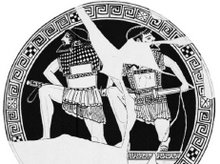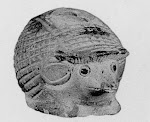"Over the last half
century, a schism developed over hoplite combat that has devolved into a bellum sacrum, with an orthodoxy assailed
by an increasingly popular heresy. The
orthodox position, championed by Hanson, Luginbill, and Schwartz, portrays
hoplites as lumbering masses of men that charged directly into each other and
contested the battlefield by attempting to physically push their foes. Van Wees, Krentz, and Goldsworthy, describe
hoplites as closer to skirmishers, fighting in an opened order, and often
paired with missile troops. Any “push”
was either a figurative description or uncoordinated shield-bashing. I believe they are both in some measure
correct, and often equally wrong, because this debate has forced historians to
stray far from their fields of study. Their
arguments suffer from an insufficient understanding of the physics and
mechanics of large masses or crowds. Group
behavior is my field, and, with the context that I can provide for their
arguments, I shall make an attempt at syncretism."
That is how the article opened, and I think both sides in the debate will find explanations for things they hold true and the other side denies. I hope in the end, after reading this, you will see that there really is not such a divide between the opinions of both camps once we cast off what is not physically likely.





2 comments:
I used to be a subscriber to ancient warfare magazine, and I will be again at some point in the near future, and I would love to read the rest of this article, as I think any true and realized insight into this kind of warfare is much-needed in today's world. Many make opinions and judgments without the first-hand knowledge or understand of crowd mechanics and simple physics, to back what they say up.
Love you work.
Interesting contribution to this subject. I hope it reaches sufficient mass to be considered by the leading proponents in ancient warfare.
I definitely think much of the pushing was relatively slow motion quite contrary to popular images though slow could turn into fast with little warning if one side gave way or some event such as the fall of a leader gave extra impetus to one side.
Considering horses aren't able to pack into as compact as mass as humans and while a horse can lean the transfer of energy and mass is much less efficient than amongst thinner more vertical humans so that ranks of sufficient depth can stop a horse pushing forward but how many ranks it takes to guarantee such result is open debate. I theorize somewhere between 6-10 for the average mass of a warhorse which is around 1100 lb as somewhere between half and 1/4 of that mass is probably what the infantry line needs to match as even a 2nd rank of cavalry 'pushing' behind is unlikely to transfer their mass nearly as efficiently.
The interesting point is that to generate the forces mentioned by the crowd studies requires concentrated pushing and very tight mass of men- where a cavalry charge might not arrive in the same way as 2 opposing lines of hoplites it makes the defending infantry much less likely to be packed close enough together initially to efficiently stop the cavalry.
If only 4-8 ranks deep and the first 2-3 ranks are overrun and the next 5-6 ranks compact can they generate enough force to resist the cavalry? I've read various mentions that commanders considered ranks to stop a cavalry charge around 8-12 deep and expect the reason is that even though 6 deep ranks could theoretically generate the force to oppose a cavalry push the way in which that force arrives means that the first couple ranks are pushed down/compacted back into the rear ranks which then stiffen and the cavalry is forced to retreat to try again.
The very tightness of such a compact mass as described in your work and the crowd studies means that the common thought that riders could easily be pulled off their horses or otherwise attacked by the infantry is false. At the same time it means well armored horses aren't absolutely necessary as the infantry are unable to to much more than overhand strikes at the cavalry similar to the strikes of hoplites described.
Instead the cavalry and infantry would be at a relative standstill just like 2 lines of hoplites until the infantry began a counter push which horses would need to back up or stumble away from without the same ability as a mass of men to compact together and oppose the push.
Post a Comment